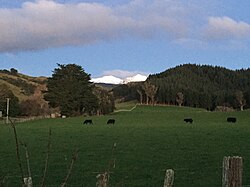|
Makahika
Makahika is a rural locality in the Horowhenua District of the Manawatū-Whanganui region of New Zealand's North Island. It is located in the Makahika Stream valley. The stream runs southwest from the Tararua Range to join the Ōhau River.[3] The Mangahao Makahika Track is a 15 km tramping track through the Tararua Range which takes 6-8 hours one-way depending on direction.[4] Glamping accommodation is available at Arete Village, part of the Makahika Outdoor Pursuits Centre.[5] DemographicsMakahika statistical area covers 170.32 km2 (65.76 sq mi).[1] It had an estimated population of 1,080 as of June 2024, with a population density of 6.3 people per km2.
Makahika had a population of 960 at the 2018 New Zealand census, an increase of 102 people (11.9%) since the 2013 census, and an increase of 153 people (19.0%) since the 2006 census. There were 372 households, comprising 504 males and 456 females, giving a sex ratio of 1.11 males per female. The median age was 50.6 years (compared with 37.4 years nationally), with 138 people (14.4%) aged under 15 years, 138 (14.4%) aged 15 to 29, 495 (51.6%) aged 30 to 64, and 189 (19.7%) aged 65 or older. Ethnicities were 91.9% European/Pākehā, 11.9% Māori, 2.5% Pasifika, 2.5% Asian, and 1.9% other ethnicities. People may identify with more than one ethnicity. The percentage of people born overseas was 16.2, compared with 27.1% nationally. Although some people chose not to answer the census's question about religious affiliation, 56.2% had no religion, 33.4% were Christian, 0.6% had Māori religious beliefs, 0.3% were Buddhist and 1.2% had other religions. Of those at least 15 years old, 138 (16.8%) people had a bachelor's or higher degree, and 168 (20.4%) people had no formal qualifications. The median income was $30,000, compared with $31,800 nationally. 135 people (16.4%) earned over $70,000 compared to 17.2% nationally. The employment status of those at least 15 was that 372 (45.3%) people were employed full-time, 150 (18.2%) were part-time, and 21 (2.6%) were unemployed.[6] References
|
|||||||||||||||||||||||||||||||||||||||||||||||||||||||||

